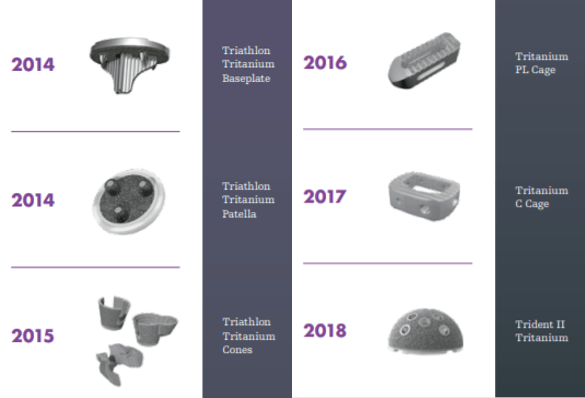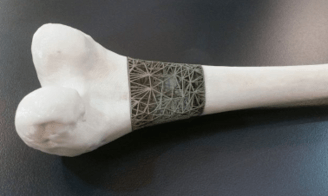How Stryker is using 3D printing to bring personalized medicine to orthopedic surgery

Riding new waves of additive manufacturing and personalization in medicine, Stryker could be poised to offer custom orthopedic implants such as hip replacements and spinal disks. Stryker, a Fortune 500 Michigan-based medical device manufacturer that specializes in orthopedic devices, is increasingly investing in additive manufacturing, signaling a long-term bet on 3D printing as a key to innovation in orthopedic implants.
Riding new waves of additive manufacturing and personalization in medicine, Stryker could be poised to offer custom orthopedic implants such as hip replacements and spinal disks. Stryker, a Fortune 500 Michigan-based medical device manufacturer that specializes in orthopedic devices, is increasingly investing in additive manufacturing, signaling a long-term bet on 3D printing as a key to innovation in orthopedic implants.
Additive manufacturing has significant potential to improve orthopedic surgical outcomes by producing implants that better resemble the tissue to be replaced. Currently, most commercial activity with additive manufacturing focuses on standard (non-custom) implants, most commonly tibial and spinal implants 1. However, new additive manufacturing methods allow engineers to create more anatomically-accurate devices requiring designs that are difficult to produce with traditional subtractive methods. These designs require challenging geometries, fine grooves, and high-porosity patterns that are possible only with precise lasers used in additive manufacturing 1,2. In addition to improving standard implants, additive manufacturing also has the potential to help companies create individual or population-specific implants based on patient scans, though these uses are still emerging 1.
Beyond enabling previously un-manufacturable product features, additive manufacturing also R&D advantages. New techniques produce minimal waste and significantly reduce product development timelines 3. Stryker is leveraging both product and R&D advantages to accelerate the expansion of a line of superior joint replacement and spinal devices that has the potential to significantly improve surgical outcomes through better fit and positioning within patients’ bodies.
In the short-term, Stryker seems to be focusing on scaling its business for standard 3D printed implants. Since 2014, the company has launched eight new implants using additive manufacturing 4.
Major Stryker commercial launches 2014-2018 [6]
Despite these innovations, Stryker acknowledges its years of experience in traditional manufacturing provide cost advantages that, in the near term, remain difficult to recreate with 3D printing 5. To minimize risk to its existing business and maximize innovation possible, Stryker seems to be focused on 3D printing new products rather than trying to 3D print existing products. CEO Kevin Lobo says the focus for the next couple years is on “the pipeline of innovative new geometries that can’t be made without 3D printing” and that “it’s not about trying to replace our products and drive down cost,” though that might be a focus on a more long-term horizon 5. While Stryker isn’t upending its existing products with 3D printing, it has focused on building a scalable capability. In 2017, the company spent an estimated $400M constructing a new additive manufacturing facility in Cork, Ireland 6. 2017 also brought a new partnership between Stryker and GE Additive (GE’s 3D printing arm) – the partners hope to further industrialize medical 3D printing, likely by leveraging GE’s Predix technology, which monitors 3D printers and collects data to improve quality and predictive maintenance capabilities 7. These actions emphasize a focus on improving efficiency in a way that may enable lower costs and expanded capabilities in the future.
Stryker seems to be searching for longer-term partnerships through which it can develop the capabilities required to deliver customized implants in the future. In 2017, Stryker announced a five- year project focused on developing a capability to produce “just in time” implants for bone cancer patients. In conjunction with the Australian Government and Universities in Melbourne and Sydney, Stryker is investing $12.1 M with the hopes to be able to “custom print an implant to precisely fill the space left after removal of diseased bone,” all while patients are in the operating room 8. Printing an implant just in time during a surgery will require major changes to Stryker’s existing R&D process. The investment also signals that Stryker believes it can create a scalable capability for customized implants where the benefits outweigh the costs.
3D printed bone replacement prototype for cancer patients [8]
To maximize its partnerships, Stryker should consider leveraging patient data to further customize its implants. Stryker’s SOMA system, which uses a comprehensive database of CT scans and 3D bone models to assess population differences in bone morphology and density, has been used only to develop standard designs to-date 5. In the near-term Stryker could consider using the data to create variations of standard 3D printed implants suited for different patient types. In the medium-term, Stryker may consider leveraging SOMA and the data of its growing partners to drive customization of implants for specific patients based on patient-specific factors.
As Stryker scales its additive manufacturing capability, it will need to decide how to balance a new pipeline of products with its legacy products. What criteria should Stryker use to evaluate whether it should start manufacturing its legacy implants with additive methods? Additionally, given heavy regulations over medical devices, how should Stryker manage risk in the regulatory environment as it invests more heavily in personalized 3D printed implants?
[Word Count: 795]
[1] Mark Crawford, “Manufacturing in Layers: 3D Printing’s Impact on Orthopedics,” Orthopedic Design and Technology, August 15, 2017, [https://www.odtmag.com/issues/2017-08-01/view_features/manufacturing-in-layers-3d-printings-impact-on-orthopedics/48615], accessed November 2018.
[2] Raymond Golish, Steven Kurtz, and Barbara Boyan. “Can 3D Printing Revolutionize Orthopedic Devices?” American Academy Of Orthopaedic Surgeons Now. January, 2018. [https://www.aaos.org/AAOSNow/2018/Jan/Cover/cover01/?ssopc=1], accessed November 2018.
[3] Megan Hsu, Meraaj Haleem, and Wellington Hsu. “3D Printing Applications in Minimally Invasive Spine Surgery”, Minimally Invasive Surgery, vol. 2018, Article ID 4760769, 8 pages, [https://doi.org/10.1155/2018/4760769], accessed November 2018.
[4] Lewis Mullen, “Press ‘print’- the 3D printing revolution,” interview by Kim Thomas. May 8, 2017, http://www.medicaldevice-developments.com/features/featurepress-print-the-3d-printing-revolution-5845943/.
[5] Rubenfire, Adam, “Stryker to Build 3D printing Facility”, Modern Healthcare, January 29, 2016, [https://www.modernhealthcare.com/article/20160129/NEWS/160129849], accessed November 2018.
[6] Stryker, 2017 Annual Report, p. 10, [https://www.stryker.com/content/dam/stryker/about/annual-review/2017/SYK_AR17_Annual_Review_2017.pdf], accessed November 2018.
[7] Scott, Clare, “GE Additive Announces Partnership with Stryker; Adds Predix Platform to Concept Laser 3D Printers”, 3DPRINT, June 14, 2017, [https://3dprint.com/177926/ge-additive-stryker-predix/], accessed November 2018.
[8] James Giggacher, “Just-in-time 3D implants set to transform tumor surgery”, press release, October 30, 2017. RMIT University website, [https://www.rmit.edu.au/news/all-news/2017/oct/just-in-time-3d-implants-set-to-transform-tumour-surgery-], accessed November 2018





I was interested to read that the strategic focus is on printing new products rather than existing products. How can Stryker prove that the 3D-printed products work just as well as existing products without setting up some kind of apples-to-apples comparison? I’m curious what metrics are being employed to assess the effectiveness of the new 3D printed products and thereby convince consumers that they should feel confident about the products.
I think the just-in-time delivery idea is a very cool concept, but raises some big safety/reliability concerns for me. Stryker needs to balance its ability to produce JIT with its ability to inspect JIT – it sounds great to print an implant on the spot and put it right into someone’s body, but some thought must be given to inspection. Screening for defects usually involves non-destructive testing that is performed by specially trained personnel and is not as well suited to decentralized production as 3D printing is. If Stryker is truly dedicated to JIT manufacturing of custom implants on-site while the patient is in surgery, they must also develop decentralized methods for inspection that can be readily automated and also performed JIT.
Similar to NYC Writer, I’m curious how significant the improvement in outcomes will be for custom 3D implants compared to current orthopedic products. Since cost savings appear unlikely in the short term, demonstrating this difference will be critical in order to increase adoption. This may partially be due to consumers/physicians comfort with current products, increasing barriers to switch unless outcomes are significantly higher, but I believe that an even more significant barrier will be insurance companies. Insurers typically put constraints on what they’re willing to reimburse, and they will see little incentive to reimburse the new products unless the improvement in outcome is more significant than the increase in costs.
I think this technology shows tremendous promise. I am interested by the regulatory risk question you pose. Specifically, I imagine litigation becomes a much bigger issue when implants are custom to one person’s body. It is almost easier to accuse Stryker of improperly printing an implant since it is specific to an individual and other users success stories can’t be used to minimize the plaintiff’s case. Although this product shows tremendous potential for improving many lives, I am sure the proper boundaries will need to be set for it to be used in clinical settings.